Hasegawa 1/48 FW-190A-4
|
KIT #: |
Jt 91 |
|
PRICE: |
$24.95 when new |
|
DECALS: |
Two option |
|
REVIEWER: |
Tom Cleaver |
|
NOTES: |
Lifelike Decals 48-019, “Focke Wulf Fw-190 Part 2" |
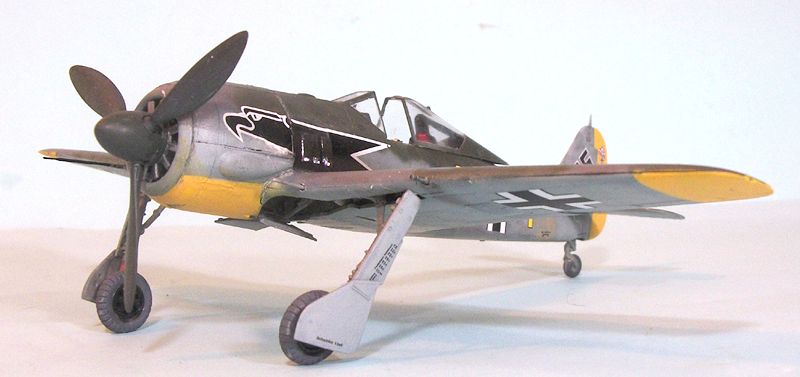
1942 could be called “the year of the Wurger.”
While only 224 Fw-190As had been accepted by the
Luftwaffe by the
end of 1941, 1,878 would be produced at three different factories during 1942,
the third being the Fieseler plant at Kassel that began production in May 1942.
(For those who worry about these things, the differing camouflage colors of the
early Fw-190A airplanes through the Fw-190A-3 is due to the different factories
not operating from a single standard until the summer of 1942).
The last of the early “short-nose” Focke-Wolf fighters, the Fw 190A‑4 was
introduced on the production lines over the summer of 1942.
This sub-type differed from the preceding Fw-190A-3 by being equipped
with the MW 50 power boost system to obtain additional power below the rated
altitude of the BMW 801D-2 engine. By injecting a water‑methanol mixture into
the cylinders, the engine could briefly sustain a compression over the redline
and get a little more horsepower.
Beyond this, the only real visual difference from the A‑3 was that the A‑4 added
a short radio antenna atop the vertical fin. The Fw-190A-4 was the most-produced
sub-type of the early Fw-190s.
The Fw-190A-4 dominated air combat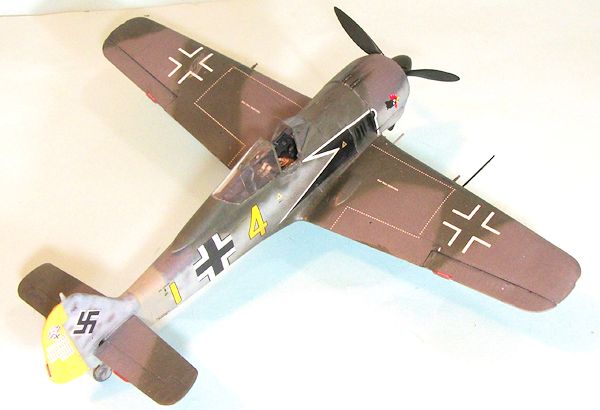 on the Channel Front until the summer
of 1943.
Even the hurried
introduction of the new Supermarine Spitfire Ixc beginning in July 1942 did
little to redress the balance; the Spitfire IX with its Merlin-60 series engine
with two-stage blower just brought the Spitfire up to a position of relative
equality with the Fw-190. The two were so evenly-matched that Johnny Johnson,
eventually the leading ace in the Spitfire IX, said that the outcome of combat
between the two was entirely dependent on pilot skill.
on the Channel Front until the summer
of 1943.
Even the hurried
introduction of the new Supermarine Spitfire Ixc beginning in July 1942 did
little to redress the balance; the Spitfire IX with its Merlin-60 series engine
with two-stage blower just brought the Spitfire up to a position of relative
equality with the Fw-190. The two were so evenly-matched that Johnny Johnson,
eventually the leading ace in the Spitfire IX, said that the outcome of combat
between the two was entirely dependent on pilot skill.
Only JG 26 was left in northern France with JG 2 on the Brittany
Peninsula and JG 1 in Holland after the transfer of Luftwaffe units to
the east to take part in Case Barbarossa in the summer of 1941.
With a maximum of around 150 aircraft, primarily Fw-190s though some
Bf-109Gs began appearing in the summer of 1942 to provide better high altitude
capability, these three Jagdgeschwadern kept the Allies essentially at
bay on the Channel Front until the summer of 1943 when units of the 8th
Air Force began to appear in greater numbers.
Siegfried Schnell:
Born in 1916 in the state of Brandenburg, Siegfried Schnell joined the
National Socialist Flying Clubs in 1933 and soon demonstrated a natural skill as
a glider pilot.
He joined the
Luftwaffe in 1936 and was a Feldwebel with 4./JG 2 by the outbreak of war
in September 1939.
JG 2 remained in
the West, and Schnell did not see combat until the Blitzkrieg of May 1940.
His first victory was a French MB.152, shot down on May 14.
His star began to rise during the Battle of Britain and he scored
regularly.
By November he was
commissioned a Leutnant, and scored his 20th victory on
November 7 off the Isle of Wight, for which achievement he was awarded the
Knight’s Cross later that month.
Throughout the spring of 1941 he continued to score against the RAF during the
“Non-Stop Offensive.”
On June 24,
1941, he was appointed Staffelkapitän of 9./JG 2.
Over July 8-9 he shot down nine Spitfires - a considerable achievement in
the Bf-109F - to reach his 44th victory making him one of the top pilots in JG
2, and was immediately awarded the Knight’s Cross with Oak Leaves; at the time
he was one of the leading experten of the
Geschwader.
JG 2 equipped
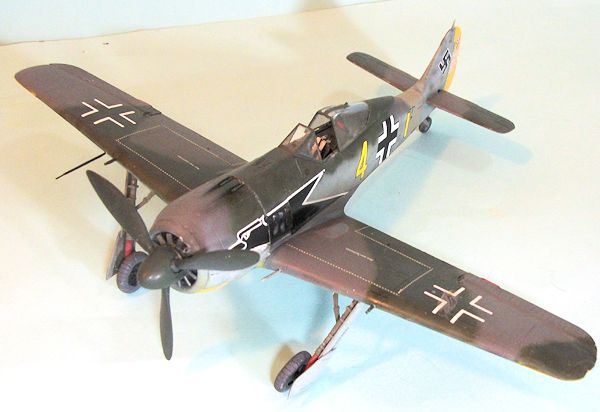 with the Fw-190A shortly after JG 26. Schnell was given
temporary command of III/JG 2 from December 9, 1941 to January 28, 1942 while
Gruppenkommandeur Hans "Assi" Hahn was on leave.
He scored his 52nd victory on February 12, 1942
while providing cover for the Scharnhorst,
Gneisenau and
Prinz Eugen in the “Channel Dash.”
During the day-long air battles over Dieppe on August 19, 1942, he shot
down five Spitfires during three missions to reach his 71st victory.
with the Fw-190A shortly after JG 26. Schnell was given
temporary command of III/JG 2 from December 9, 1941 to January 28, 1942 while
Gruppenkommandeur Hans "Assi" Hahn was on leave.
He scored his 52nd victory on February 12, 1942
while providing cover for the Scharnhorst,
Gneisenau and
Prinz Eugen in the “Channel Dash.”
During the day-long air battles over Dieppe on August 19, 1942, he shot
down five Spitfires during three missions to reach his 71st victory.
In the spring of 1943, the Luftwaffe came up with the ill-conceived idea
of rotating fighter units between the Eastern and Western Fronts, despite the
very different combat conditions that existed on each.
III/JG 54 was transferred to the West in May 1943 and Schnell, now with
80 victories, was appointed Gruppenkommandeur.
He spent most of the summer training the pilots in the high altitude
combat they would face against the 8th Air Force, re-entering combat
in time to take part in opposing the Scheweinfurt-Regensburg Mission and the
bitter battles that fall which culminated in the Schweinfurt Raid of October 14,
1943 in which the Luftwaffe put paid to the USAAF’s strategy of
unescorted deep-penetration daylight bomber raids.
On January 11, 1944, during the 8th Air Force mission against
Oschersleben, Schnell shot down three B-17s for his 88th, 89th,
and 90th victories.
On February 1, Schnell was given orders to the Eastern Front, taking
command of IV/JG 54 outside Leningrad on February 11, 1944. Flying the
Bf-109G-6, he scored three victories over the next twelve days but failed to
adapt to conditions on the Eastern Front.
He was shot down and killed on February 25, 1944, during the Soviet
offensive against Narva.
He
had flown over 500 combat missions and ended with 93 confirmed victories,
including 12 B-17s, making him one of the Luftwaffe’s top bomber-killers.
His tally of 90 on the Western Front made him the 11th ranking German
experte over the Western Allies.
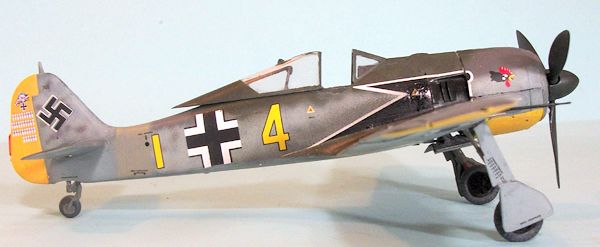 Hasegawa’s limited-run Fw-190A-4, a modification based on the Trimaster/Dragon
Fw-190A-4, first appeared in 1995, and has had a few re-releases in the years
since.
It can actually be assembled
as either an Fw-190A-3 or Fw-190A-4, since it has separate parts for the upper
vertical fin to cater to the differences in antenna between the two.
The kit provides decals for an Fw-190A-4 in winter camouflage flown by JG
54 Kommodore Hannes Trautloft, and a Fw-190A-4 flown by Traultloft’s successor
Hubertus von Bonin, in the three color field-adapted camouflage created by JG 54
in 1943.
Hasegawa’s limited-run Fw-190A-4, a modification based on the Trimaster/Dragon
Fw-190A-4, first appeared in 1995, and has had a few re-releases in the years
since.
It can actually be assembled
as either an Fw-190A-3 or Fw-190A-4, since it has separate parts for the upper
vertical fin to cater to the differences in antenna between the two.
The kit provides decals for an Fw-190A-4 in winter camouflage flown by JG
54 Kommodore Hannes Trautloft, and a Fw-190A-4 flown by Traultloft’s successor
Hubertus von Bonin, in the three color field-adapted camouflage created by JG 54
in 1943.
 The only two places where the kit creates any problems in construction
are in the placement of the underwing cannon fairings, which will leave gaps if
they are not trimmed and test fitted before being attached, and in insuring that
the engine in placed correctly inside the cowling.
The kit has you attach the assembled
engine to the fuselage, then attach the oil cooler fairings to either side of
the lower half of the cowling, then attach upper and lower halves of the cowling
to each other around the engine.
Careful fitting is required to be sure that there are no gaps to all this.
This modification of the Trimaster original is far more “fiddly” than the
very fiddly methodology Trimaster came up with.
The only two places where the kit creates any problems in construction
are in the placement of the underwing cannon fairings, which will leave gaps if
they are not trimmed and test fitted before being attached, and in insuring that
the engine in placed correctly inside the cowling.
The kit has you attach the assembled
engine to the fuselage, then attach the oil cooler fairings to either side of
the lower half of the cowling, then attach upper and lower halves of the cowling
to each other around the engine.
Careful fitting is required to be sure that there are no gaps to all this.
This modification of the Trimaster original is far more “fiddly” than the
very fiddly methodology Trimaster came up with.
Having redesigned the lower area of the fuselage halves so there is not
the huge hole below the cockpit that can lead to the fuselage not fitting to the
upper wing with the Trimaster kits, attaching the wing and fuselage
sub-assemblies is quite easy.
Once the horizontal stabilizers were attached and everything had set up,
it was time for painting.
After applying flat black on the panel lines for pre-shading, I followed
the painting instructions in the very good Lifelike Decals sheet. I applied
Tamiya Flat Yellow to the lower cowling, lower wingtips, the rear fuselage and
the rudder.
I then masked off the
cowling, wingtips and rudder, and applied Xtracrylix RLM76 Lichtblau to
the lower surfaces and fuselage sides, over the yellow band on the lower
fuselage.
I then applied Xtracrylix
RLM 74 Graugrun and RLM 75
Grauviolett in the standard Fw-190
camouflage 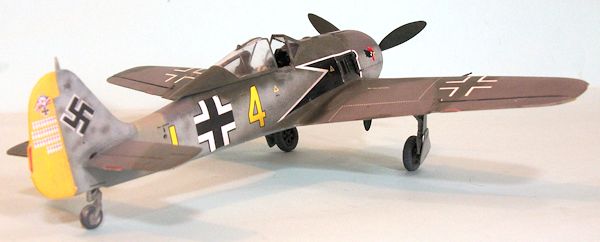 pattern.
When all was
dry, I unmasked the yellow areas and gave the model a coat of Xtracrylix Gloss
Varnish.
pattern.
When all was
dry, I unmasked the yellow areas and gave the model a coat of Xtracrylix Gloss
Varnish.
The Lifelike Decals are very good.
They accurately portray Schnell’s Fw-190A-4 he flew during the spring and
summer of 1942, and get the JG 2 black/white Eagle correct on the left side with
the Hahn-inspired “cockerel” on the right side of the cowling. I managed to
screw up the head of the Eagle, and was fortunate to find a slightly-different
JG 2 Eagle on an old Aeromaster sheet that I could use to repair the damage.
The Lifelike Decal symbol is by far the more accurate, so be careful in
applying these very thin decals and you won’t suffer that problem.
I gave the model a coat of Xtracrylix Clear Flat, then applied Tamiya
“Smoke” for exhaust staining.
Photos show Schnell’s airplane was well-maintained, so I did not weather it
further.
I attached the landing
gear and prop.
I used a set of
Eduard seatbelts in the cockpit and posed the canopy open.
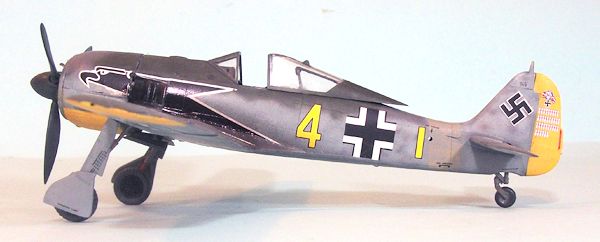 Hasegawa’s 1/48 Fw-190A-series kits are far more accurate than the Tamiya
Wurgers, which have gear legs that are too short and wheels that are too small.
They assemble far more easily than their Trimaster cousins, and are the
only 1/48 Fw-190 kits that have the gear legs designed in such a way that it is
difficult to attach them wrong, one of the main faults found with Fw-190 models.
They are out of production at the current time but can be found on eBay
and on dealer’s tables at shows.
Highly recommended.
Hasegawa’s 1/48 Fw-190A-series kits are far more accurate than the Tamiya
Wurgers, which have gear legs that are too short and wheels that are too small.
They assemble far more easily than their Trimaster cousins, and are the
only 1/48 Fw-190 kits that have the gear legs designed in such a way that it is
difficult to attach them wrong, one of the main faults found with Fw-190 models.
They are out of production at the current time but can be found on eBay
and on dealer’s tables at shows.
Highly recommended.
Thanks to the late modeler who left his stash behind for me to purchase
for the review kit.
Tom Cleaver
May 2013
If you would like your product reviewed fairly and fairly quickly, please
contact
the editor
or see other details in the
Note to
Contributors.
Back to the Main Page
Back to the Review Index Page


 on the Channel Front until the summer
of 1943.
Even the hurried
introduction of the new Supermarine Spitfire Ixc beginning in July 1942 did
little to redress the balance; the Spitfire IX with its Merlin-60 series engine
with two-stage blower just brought the Spitfire up to a position of relative
equality with the Fw-190. The two were so evenly-matched that Johnny Johnson,
eventually the leading ace in the Spitfire IX, said that the outcome of combat
between the two was entirely dependent on pilot skill.
on the Channel Front until the summer
of 1943.
Even the hurried
introduction of the new Supermarine Spitfire Ixc beginning in July 1942 did
little to redress the balance; the Spitfire IX with its Merlin-60 series engine
with two-stage blower just brought the Spitfire up to a position of relative
equality with the Fw-190. The two were so evenly-matched that Johnny Johnson,
eventually the leading ace in the Spitfire IX, said that the outcome of combat
between the two was entirely dependent on pilot skill. with the Fw-190A shortly after JG 26. Schnell was given
temporary command of III/JG 2 from December 9, 1941 to January 28, 1942 while
Gruppenkommandeur Hans "Assi" Hahn was on leave.
He scored his 52nd victory on February 12, 1942
while providing cover for the Scharnhorst,
Gneisenau and
Prinz Eugen in the “Channel Dash.”
During the day-long air battles over Dieppe on August 19, 1942, he shot
down five Spitfires during three missions to reach his 71st victory.
with the Fw-190A shortly after JG 26. Schnell was given
temporary command of III/JG 2 from December 9, 1941 to January 28, 1942 while
Gruppenkommandeur Hans "Assi" Hahn was on leave.
He scored his 52nd victory on February 12, 1942
while providing cover for the Scharnhorst,
Gneisenau and
Prinz Eugen in the “Channel Dash.”
During the day-long air battles over Dieppe on August 19, 1942, he shot
down five Spitfires during three missions to reach his 71st victory. Hasegawa’s limited-run Fw-190A-4, a modification based on the Trimaster/Dragon
Fw-190A-4, first appeared in 1995, and has had a few re-releases in the years
since.
It can actually be assembled
as either an Fw-190A-3 or Fw-190A-4, since it has separate parts for the upper
vertical fin to cater to the differences in antenna between the two.
The kit provides decals for an Fw-190A-4 in winter camouflage flown by JG
54 Kommodore Hannes Trautloft, and a Fw-190A-4 flown by Traultloft’s successor
Hubertus von Bonin, in the three color field-adapted camouflage created by JG 54
in 1943.
Hasegawa’s limited-run Fw-190A-4, a modification based on the Trimaster/Dragon
Fw-190A-4, first appeared in 1995, and has had a few re-releases in the years
since.
It can actually be assembled
as either an Fw-190A-3 or Fw-190A-4, since it has separate parts for the upper
vertical fin to cater to the differences in antenna between the two.
The kit provides decals for an Fw-190A-4 in winter camouflage flown by JG
54 Kommodore Hannes Trautloft, and a Fw-190A-4 flown by Traultloft’s successor
Hubertus von Bonin, in the three color field-adapted camouflage created by JG 54
in 1943. The only two places where the kit creates any problems in construction
are in the placement of the underwing cannon fairings, which will leave gaps if
they are not trimmed and test fitted before being attached, and in insuring that
the engine in placed correctly inside the cowling.
The kit has you attach the assembled
engine to the fuselage, then attach the oil cooler fairings to either side of
the lower half of the cowling, then attach upper and lower halves of the cowling
to each other around the engine.
Careful fitting is required to be sure that there are no gaps to all this.
This modification of the Trimaster original is far more “fiddly” than the
very fiddly methodology Trimaster came up with.
The only two places where the kit creates any problems in construction
are in the placement of the underwing cannon fairings, which will leave gaps if
they are not trimmed and test fitted before being attached, and in insuring that
the engine in placed correctly inside the cowling.
The kit has you attach the assembled
engine to the fuselage, then attach the oil cooler fairings to either side of
the lower half of the cowling, then attach upper and lower halves of the cowling
to each other around the engine.
Careful fitting is required to be sure that there are no gaps to all this.
This modification of the Trimaster original is far more “fiddly” than the
very fiddly methodology Trimaster came up with. pattern.
When all was
dry, I unmasked the yellow areas and gave the model a coat of Xtracrylix Gloss
Varnish.
pattern.
When all was
dry, I unmasked the yellow areas and gave the model a coat of Xtracrylix Gloss
Varnish.